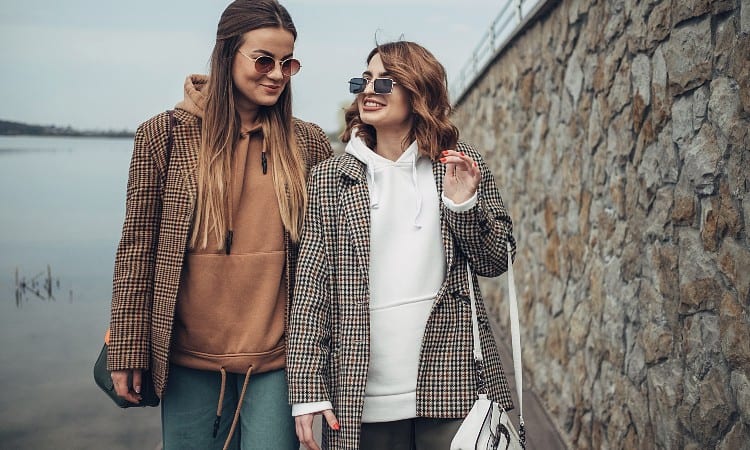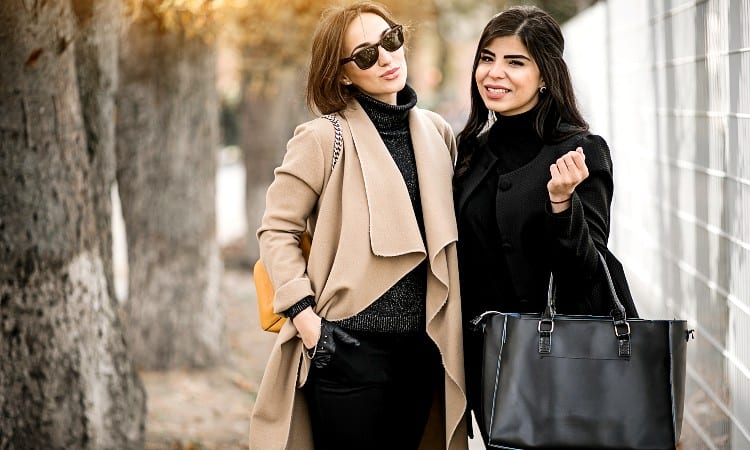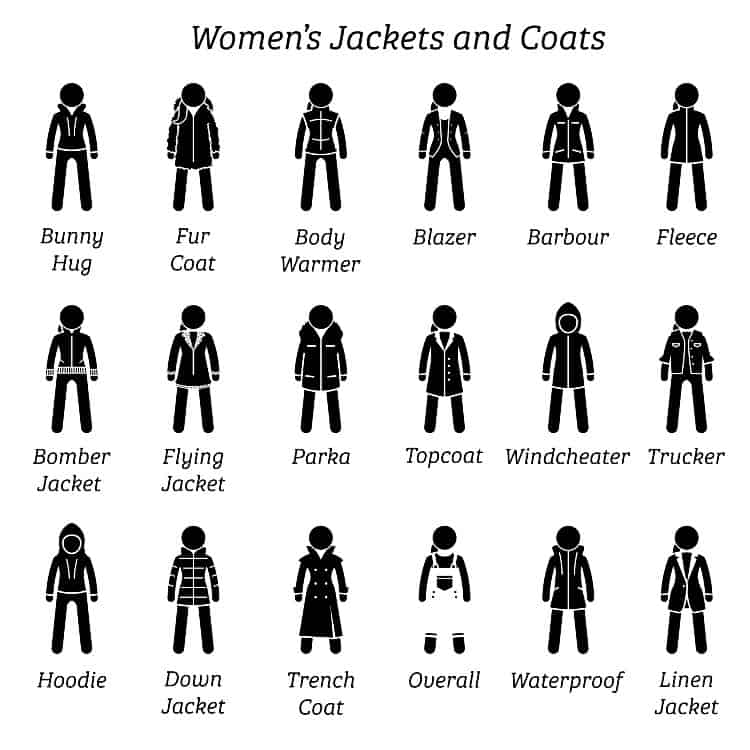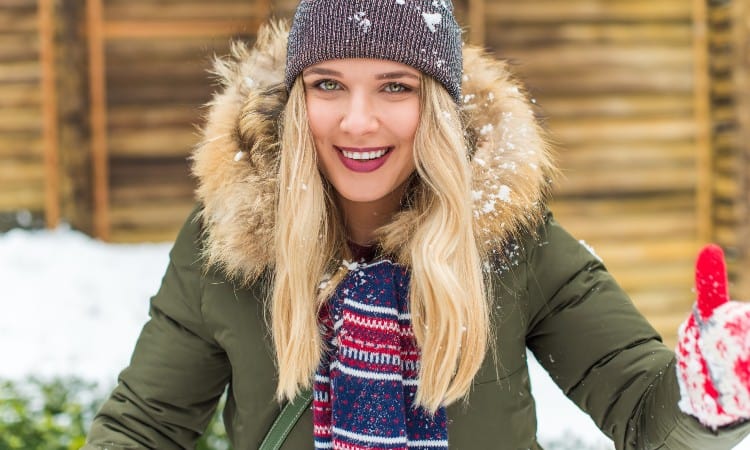Jackets and coats keep you warm on a chilly day, though the two categories of clothing also have quite a few differences. But when you think about it, why do you call a down-filled coat for skiing a winter coat and a blazer or tuxedo top a jacket? When you compare a coat vs a jacket, what is the difference between them?
The main difference between a coat and a jacket is that coats fall to hip length or even longer while jackets end at or above the hip. Another key difference is that coats often provide more warmth and insulation than jackets. Jackets also often serve more of a fashionable or decorative purpose than coats, which provide warmth.
In this article, you will find out what distinguishes a jacket from a coat. You will discover the most popular styles of coats and jackets. Finally, you will learn how jackets and coats compare to sweaters and parkas.
Quick Navigation
What is a Coat?

A coat is a warm outer garment worn over top of other clothing meant to protect the wearer from extreme temperatures. Coats often have a hip-length or longer length, though they can also end at the waist. They always have sleeves and often have a looser fit to allow for layering beneath them.
Some popular styles of coats like peacoats may also have a more formal appearance than most jackets. Other popular types of coats include down-filled coats, trench coats, wrap coats, and parkas.
Are coats warmer than jackets? Yes, coats almost always use heavier, more insulating fabric than jackets. This makes them much warmer.
You also sometimes see the term “overcoat” used to describe a heavy winter coat such as a full-length peacoat. This is an old-fashioned term that just means a coat means to wear overtop of other garments.
The word “coat” comes from an old Latin word meaning heavy woolen clothing, though it first came into use in English to describe a coat of chain mail. Imagine how much a coat made out of interlocking metal circles would weigh!
This is the kind of heft and heaviness associated with the word coat.
What is a Jacket?

A jacket is a kind of outerwear for the upper body that usually ends at the waist or the hips. Jackets often open in the front and have a fairly close fit. They provide less warmth than a coat and may serve a more decorative purpose.
Popular styles of jackets include bomber jackets, varsity jackets, denim and leather jackets, suit jackets, and blazers. Most of the time, jackets have a less formal style than coats. The exception to this rule is jacket styles such as suit jackets and tuxedo jackets.
Is a jacket a type of coat? Not exactly. A jacket usually serves a different purpose than a coat–it has a lighter weight and a closer fit, for instance.
But it’s also true that you will not find any “clothing rules” that 100% determine whether a particular garment is a jacket or a coat.
This means that you sometimes see the terms jacket and coat used interchangeably.
One of the reasons you can use the term either jacket or coat to describe a warm outerwear garment is that the English language has absorbed terms from multiple other languages over time. Most languages do this to a certain extent, but England itself got conquered by a French ruler named William the Conquerer in the tenth century.
This made French the ruling language of England for a while! This is why so many French words like “jaquet” turned into a regular part of English. It is also why you often find two words that mean variations on the same thing in English, like coat and jacket!
Coat vs Jacket: What is the Difference?

The biggest difference between jackets and coats is that jackets usually provide less insulation and have a shorter length. Coats also always serve as outerwear, while jackets like blazers may serve a more decorative function and can also be worn indoors. Most of the time, coats use heavier material than jackets, too.
While you will not find a hard-and-fast fashion rule that separates coats from jackets, there are clear differences in how these two types of garments usually get classified.
1. Length
The most obvious distinction between jackets and coats is the length because coats often have a longer length than jackets.
Jackets usually have a shorter length, ending at the waist or just below the waist. Coats may end at the waist, as in the case of a down-filled puffer coat, but they typically fall at least to the hip. Some coats, such as trench coats and wrap coats, reach all the way down to the ankles!
The reason for this is simple. Coats should keep you as warm as possible in cold temperatures. This means that you want a coat to cover more of your body.
Jackets, in contrast, will provide a little warmth but may also serve as indoor apparel–think of a varsity jacket worn by a high school football star, for instance.
2. Fabric Type
Jackets often contain fabric types suck as denim, leather, wool, cotton, or polyester. Coats can use many of the same types of fabric but typically use material with a thicker weave or have added layers of insulation between the coat and the lining.
You also see jackets and coats made out of fleece or lined with faux-sheepskin shearling.
Both coats and jackets typically contain multiple layers of material. These include the shell, the outer layer of fabric, the filling behind the shell, and the lining inside the garment. Most coats and jackets also feature pockets made from lining material, and some have a hood or a stylized collar.
The style of coat or jacket often determines what kind of fabric it will contain. For example, a peacoat almost always contains wool fabric, while a raincoat usually features a moisture-resistant synthetic like nylon or polyester.
A suit jacket will typically feature expensive wool or cheaper synthetic polyester designed to look like wool. A varsity jacket usually contains some kind of felt, while a denim jacket features jean fabric!
3. Fabric Weight
Besides the length of the garment, the weight of the fabric used is the greatest difference between most coats and jackets. Coats use heavy-weight materials like thick wool or deep layers of insulating filler material. In most cases, jackets use lighter, thinner materials and much less filling between the shell and the lining.
Winter coats often use wool that weighs between 14-19 oz per square yard, while the cloth sued in your typical wool suit for wearing at the office weighs only 9 or 10 oz per square yard!
Some types of coats, such as puffer/down-filled winter coats, use a light, silky material as the shell. But in this case, the garment makes up for the lack of a heavy material by adding a thick layer of filler between the shell and the lining.
4. Type of Fastening
Coats and jackets often share the same type of fasteners, though jackets use zippers slightly more often than coats.
Jackets often zip up the center front of the garment. That said, you can find plenty of jacket styles that use a button closure as well–think of suit jackets and blazers, for example.
Coats use zippers for some styles, like parkas and down-filled coats. But more formal styles like peacoats, overcoats, and trench coats typically feature button closures.
You can also find less frequently used closures like snaps, toggles, or velcro used in coats and jackets.
5. Sleeves
Coats always have sleeves, and so do most jackets. That said, a few styles of jackets may not feature sleeves, making this another key difference between the two types of garments.
One super-popular type of sleeveless jacket is technically called a gilet. In American English, it is usually referred to as a vest or a ski vest. This looks like a pared-down version of a down-filled winter coat, minus the sleeves!
Why is a gilet considered a sleeveless jacket and not a sleeveless coat? There is no clear answer here, except that this style of vest always ends at the waist. Shorter lengths usually put a garment into the jacket category rather than the coat category.
6. Fit
Generally, jackets have a much closer and tighter fit than coats. The difference in cut stems from the fact that you always use a coat as outerwear, putting it over other clothing. Jackets usually go on over other clothing but can serve as an indoor garment or part of an outfit rather than as an outdoors-only shell that you take off when you get inside again.
Jackets like suit jackets, blazers, varsity jackets, and even bomber jackets often serve as an essential element of an outfit. A peacoat, in contrast, may look great with your outfit but gets left hanging up once you reach the office or your home.
Another reason for the closer fit of jackets is that they do not need to provide as much warmth, as you will see in the next section!
7. Warmth
Coats offer more warmth and insulation than jackets. This makes coats more suitable to wear outside in cold climates, while jackets serve a more versatile purpose and can provide a limited amount of warmth indoors or outdoors in varying temperatures.
Jackets work well in the in-between seasons of fall and spring, for example. They also serve as an additional indoor layer in many seasons, depending on the style of jacket.
Coats use heavy fabrics and lots of layers. This makes them suited only to outdoor use. If you want a coat for intense outdoor activity like winter camping, you can find temperature ratings on some products.
Some coat brands no longer include temperature ratings, though, because recent studies have found that body type and even the type of activities you engage in can impact how well a coat insulates you.
8. Style
Coats and jackets both come in a variety of popular styles that have a certain amount of overlap between them. For example, you can find raincoats and rain jackets. You can find wrap coats or lightweight wrap jackets cut in the same style.
But overall, you can also find distinctive styles of coats and distinctive styles of jackets.
Popular jacket styles include bomber jackets, denim/jean jackets, leather jackets, varsity jackets, suit jackets, blazers/sports coats, and tuxedo jackets.
Popular coat styles include puffer coats, peacoats, trench coats, and parkas/anoraks.
9. Best For
Coats work best for keeping you warm in the winter, while jackets provide battle warmth at any time of the year. Beyond that, the style of a coat or jacket typically determines what it is best for.
Less formal jackets work better for physical activities like hiking because they will not make you feel overheated. Jackets can also work well as a top layer indoors, especially if you pick a lightweight version such as a blazer.
Coats almost always serve as an outer protective layer, either protecting you from cold or from rain. Most of the time, coats pretty much have one purpose, which is to keep you warm outside on a cold day!
Popular Types of Coats

Coats come in many types, shapes, and sizes, but here you can find a list of the most popular kinds of coats in the world of fashion today!
Pea Coat
One of the most stylish types of winter coats you can find is the classic peacoat. This style features heavy wool cut in a double-breasted style, often with two rows of large buttons running down the center front. Peacoats have a fairly short length, ending just below the waist.
The collar can fold up at the back of the neck as a shield against bad weather. This type of cot usually slanted slash pockets in the front, too.
Historically, peacoats come from navy and military use, where they typically featured dark blue wool. Today, of course, you can find peacoats in all different shades and colors of wool, but the style of the coat does still hint at its military origins, giving it a slightly formal appearance.
Rain Coat
Raincoats form a category all their own, as you can find them in many different cuts and styles. Today, one of the most prevalent raincoat styles is a trench coat-type garment made with waterproof nylon. You can also find the classic plasticky hooded, tube-shaped yellow coats for sale today–think of the little girl on a famous brand of salt to picture this iconic coat!
As a quick side note, short, waist-length raincoats often get termed rain jackets. You don’t see these as often today, as it is less practical to leave yourself unprotected from the waist down!
Winter Coat
The ambiguous term “winter coat” can mean anything from an ankle-length wool overcoat to a fleecy parka to a down-filled puffer coat. Let’s break this down just a bit to give you a clear idea of popular winter coat styles today.
- Down-filled coats have a thin outer shell made from a durable synthetic material like polyester and a fluffy layer of insulating fill material on the inside. You would wear this kind of winter coat on the ski slopes or for a long, chilly walk in the winter. These coats often (though not always) end at the waist, which has led to some confusion in their name–you see these coats called “down-filled jackets” or “puffer coats” interchangeably!
- Wool coats most often come in a three-quarter length style, though you can also find wool peacoats ending at the waist or wool coats that end at the hip or the ankle. You may also see this heavy, formal style of winter coat termed an overcoat or top coat.
- Wrap coats can contain lots of different types of fabric, from heavy wool to summery linen. This style of coat does not use a standard fastener and instead wraps around the body in the same manner as a bathrobe and belts closed at the waist.
- Parka/Anoraks have hoods, warm fleece or fur lining, and usually fall to mid-thigh. This type of coat comes from the Inuit people and remains extremely popular for outdoor wear in cold climates today.
Trench Coat
A trench coat features heavy, water-resistant material like gabardine or leather, though the material often contains synthetics like polyester. The style of the coat fastens with both buttons and a cloth belt and often features a shoulder cape. Trench coats always have a long length, usually ending either at the knee or mid-calf.
Trench coats get their names because they were originally worn by soldiers in WWI, literally in the trenches! The sturdy waterproof fabric helped soldiers stay dry in all that mud.
Burberry sells one of the most famous brand-name trench coats. The classic trench coat has a tan color, though you can select from a whole rainbow of colors these days!
Popular Types of Jackets
Like coats, jackets come in a wider range of types, each with its own particular function.
Suit Jacket
A suit jacket is one of the more formal types of jackets, usually made out of light to midweight wool and a silky lining. Suit jackets come in several styles, including single or double-breasted, but a suit jacket always comes with matching dress pants.
Both men and women wear suit jackets, though women’s jackets have more variety in cut and sometimes feature styles such as a peplum or asynchronous details.
Blazer
A blazer looks a lot like a suit jacket in terms of cut and fabric, but a blazer comes as a stand-alone piece rather than as part of a suit. Modern fashion trends with blazers include unconventional pairings such as wearing a blazer over a t-shirt and jeans.
Like suit jackets, blazers typically feature a lightweight shell made of fine woven material. More expensive blazers use wool or even cashmere, sometimes in fancy twill or herringbone weaves. Less expensive blazers often feature some form of woven polyester as the shell and a synthetic lining inside the garment.
Denim/Leather Jacket
Denim and leather jackets contain either denim or leather, but they also usually feature the cut of a classic bomber jacket. Bomber jackets, made popular by pilots in the world wars, have a waist-length cut, button or snap closures in the front, and a fold-over triangular collar.
Jean jackets rose to immense popularity in the 50s because of movie stars like James Dean. Leather and jean jackets still have an edgy, rebellious vibe today and can create a rugged or trendy appearance when paired with almost any outfit.
One difference is that leather jackets usually include a lining on the inside of the garment, while denim jackets typically do not.
Windbreaker
A windbreaker is a type of jacket featuring a baggy cut and a weather-resistant shell over a silky lining. It usually has close-fitting cuffs and a narrow round neckline to protect from the wind.
This type of jacket has lost some popularity these days but remains a popular choice for children or people who want to go outdoors in all types of weather.
Do Americans Say Jacket or Coat?
In some regions of the United States, Americans use particular idioms around coats and jackets, sometimes using the terms interchangeably. For instance, many Americans might call a down-filled coat a ski jacket, even though the garment meets all the qualifications for what most people would term a coat.
In general, though, the length of the garment and its level of insulation determine whether Americans call it a jacket or a coat. If the garment ends at the waist and features thin material, it almost always gets called a jacket. If it has a longer hem or provides more insulation, you can safely call it a coat!
Can You Wear a Jacket and a Coat?

You can wear a jacket and a coat at the same time in certain circumstances. If you wear a suit to work, you will probably want to wear a winter coat over the suit jacket during the winter.
Most of the time, you select a jacket to wear in more temperate weather and a coat to wear outdoors in chilly weather. You do not typically layer a winter coat over a denim jacket, for example.
Is a Parka a Coat or a Jacket?
A parka is a coat because it is longer than most jackets and usually features heavy material and a warm fleece or fur lining. All of these characteristics make it a perfect piece of heavy-duty outerwear.
Parkas–otherwise known as anoraks–often get worn in intensely cold environments like Antarctica!
People do not typically refer to a parka as a jacket because a parka is a pretty intensely insulating type of coat.
Winter Coat vs Jacket
The main difference between a winter coat and a jacket is that a winter coat often has a longer length and always uses heavier, more insulating fabric. You can find some overlap in the terminology used, though–as you saw earlier in this article, garments like a puffer coat sometimes get called a ski jacket rather than a ski coat.
Winter coats come in lots of different types and styles. A few of these, such as a wrap coat, can veer into jacket territory depending on the type of fabric used in the coat. For example, a wrap coat made of heavy-weight wool is a coat, but a wrap coat made of lightweight linen could fall into the jacket category!
Jacket vs Coat vs Sweater
Jackets, coats, and sweaters all provide warmth to the upper body, but each garment has a distinct style.
Coats often have a longer length, falling to hip length or even down to the ankle. Coats also almost always use mid to heavy-weight fabric such as wool or gabardine.
Jackets usually end at the waist and fit more closely to the body than a coat. Jackets provide a limited amount of warmth but would not suffice outdoors on a very cold day.
Sweaters differ from both coats and jackets because they always contain knitted fabric. The yarn used in the sweater could contain acrylic, wool, or several other materials, but it is always formed in a knitted structure. Sweaters do not provide as much insulation as a coat or jacket because of the air holes in the knitted structure of the cloth.
Conclusion
The biggest difference between coats and jackets is that coats have a longer length while jackets end at the waist. Coats also feature warmer fabrics and provide more insulation than most jackets. Coats also serve as outerwear and work best for outdoor activities, while you can comfortably wear most jackets indoors.
Coats sometimes have a more formal style than jackets, especially peacoats or wool winter coats. Popular styles of coats include peacoats, wool, down-filled or wrap-style winter coats, and trench coats. Popular styles of jackets include suit jackets, blazers, and denim jackets.